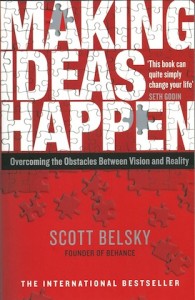The one-sentence summary
Concentrate on implementation rather than ideas, by ignoring reactionary workflow, creating windows of nonstimulation, and ignoring insecurity work.
Can’t be bothered to read it? Listen to the 5-minute summary.
WHAT THE BOOK SAYS 
- Ideas are easy. Implementation is hard, and here is how to overcome the obstacles between vision and reality.
- 100 (ideas) x 0 (executions) = 0, so it’s better to have a few ideas that actually get done.
- Dealing with stuff involves sorting them into:
1. Actionable items (do now or place on an action list)
2. Backburner items (do later)
3. Reference items (stick in a folder for possible future use)
- Attractive things work better, so make your system visually attractive.
- Sequential tasking is more effective than multitasking (suggested by this author in 2005).
- Reactionary workflow (where you just cope with what comes in) doesn’t work well. You need to exercise your own priority.
- You can be most productive by creating windows of nonstimulation – time dedicated to uninterrupted project focus.
- You also need to create the time to seek stimulation from serendipity – the time to allow seemingly unconnected ideas to gel.
- Avoid the tendency to escape the lull of a project plateau by starting a new idea – it’s just a distraction that stops you completing the original idea.
- As Seth Godin says, you need the ‘courage to ship’ – to get your idea out and about, and not be scared of the reaction it will elicit.
- Thrashing is delaying the launch of something by coming up with last-minute changes – this should be done at the beginning, not at the end.
WHAT’S GOOD ABOUT IT
- To make ideas happen you need to be part dreamer, part realist, and part spoiler, as was Walt Disney. On every project he had three rooms:
Room 1: Rampant idea generation without limits (dreaming)
Room 2: Aggregation and organisation of ideas from Room 1 (realism)
Room 3: Sweat box to critically review without restraint (spoil/kill/refine)
- Incrementalists have the ability to perform the role of both doer and dreamer – a rare skill indeed.
- Done Walls are a motivating idea – put everything the team has done on the wall as massive checklists, thereby continually reminding everyone of how much progress has been made.
- Research shows that the higher the ceiling of the place they are working in, the more creative ideas people have because they feel less constrained.
- Procrastinators typically do far too much insecurity work – stuff with no intended outcome that is quick enough to do without you realising that it’s actually a waste of time.
- ROWE companies (Results Only Work Environment) measure performance on output, not sit-put. It’s what you do, not whether you are at your desk.
WHAT YOU HAVE TO WATCH
- The title suggests an emphasis on creativity but really the book is just about how to get stuff done.
